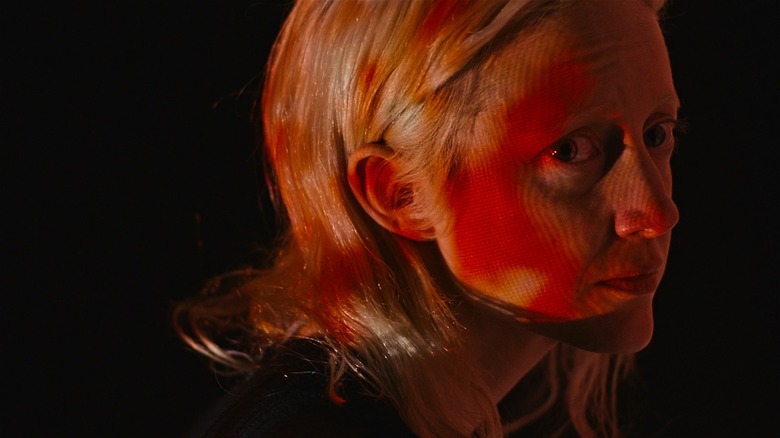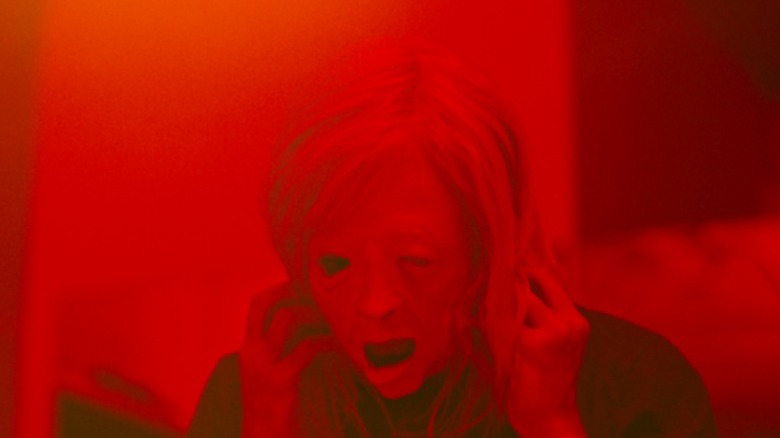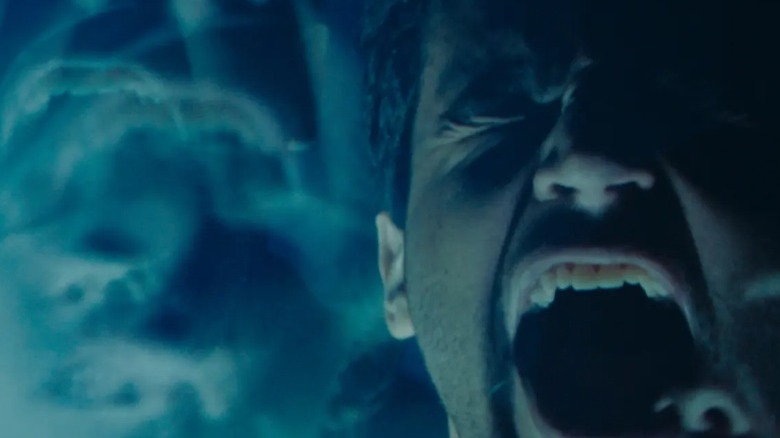How Brandon Cronenberg Pulled Off Possessor's Most Violent Moments Without CGI
Eight years after his debut feature "Antiviral," Brandon Cronenberg made the provocative sci-fi body horror, "Possessor," which pushed the envelope when it came to exploring the relationship between the mind and the body. Brilliant and subversive, "Possessor" explores an alternate timeline in which the virtual takeover of bodies is possible — a technique used by assassin Tasya Vos (Andrea Riseborough) to carry out her hits. However, when Vos' consciousness enters Colin Tate (Christopher Abbott), the latter's psyche fights back to regain control of his body, leaving Vos reeling with the after-effects of a fragmented mind and the steady erosion of identity.
Instances of violence in "Possessor" are aplenty. For starters, there is the psychological violence of robbing another human of their autonomy, where the body is forced to revolt against itself. While target elimination is Vos' end goal, she navigates her missions with the aid of physical brute force. As a result, brains are beaten to a pulp and necks are stabbed with chilling brutality.
Cronenberg presents these ideas in visceral, over-the-top ways, situating Vos' relationship with violence at the center of the story. Due to the nature of her job, and the intrusive quality of infiltrating other bodies and minds, Vos finds herself addicted to violence, thoughts of which haunt her everyday life. The violence in the film, which is central to Vos' identity as a hitman and a person gradually crumbling under the weight of dissociation, is precise and jarring, explored with bolder flair in the film's uncut version. Interestingly, these graphically extreme moments were accomplished with the aid of practical effects, which helped provide a more grounded, shocking tint to the acts portrayed on-screen.
Here's how Cronenberg and co. pulled off such scenes depicting extreme violence, including melting faces and heads being crushed in incredibly specific ways.
Using prosthetics and puppets
As Vos progresses with her final mission, the near-assimilation of her already-fragmented self with the identity she forcibly assumes culminates in the most stylized violence, and Vos interprets these impulses as primal urges. However, as Vos cannot keep a steady hold on who she is, how can she separate core impulses from borrowed ones? Things become especially ugly when the quintessential possessor starts feeling trapped inside another body instead of feeling liberated.
The reason why these violent aspects of "Possessor" — both explicit and implied — hit harder than run-of-the-mill stabbing and gouging is that the film expertly uses practical effects to grant a more tactile quality to these moments. Cronenberg talked about the process in an interview with Seventh Row, explaining the essential difference between CGI and practical effects, and how the former feels "a bit floaty" and doesn't quite hit the same:
"I like practical effects, especially with on-screen violence. The benefit to CGI is that it frees up choreography, and you can have these sort of long, one-shot action sequences, but I always find something a bit floaty about CGI blood. It doesn't really have the same impact. So I knew we were going to have to use prosthetics and puppets."
Cronenberg went on to talk about collaborating with effects and makeup designer Dan Martin, who helped create the fake heads that were used for the squashing and stabbing. A particular scene in which we get a closeup of needles entering the scalp was created with the aid of "normal-sized scalps with really well-punched hair," while a probe lens was used to intensify the visual experience. While Martin's creative ingenuity helped bring these visceral sequences to life, Cronenberg used melts and fades to achieve the surreal, out-of-body aura that permeates the film's most memorable scenes.
How Possessor uses violence to map character psychology
In the same interview, Cronenberg also talks about Vos' fetishistic relationship with violence, and how it directly informed the climactic psychic confrontation towards the end. Although Vos has familial attachments, these bonds fail to act as an emotional tether for her — instead, her urge to kill and main spills over into these safe spaces, further unmooring her from socially expected normalcy. Owing to the mission involving Colin, Vos' psychic degradation worsens, as her violent impulses are imprinted onto Colin, who uses the same impulses to thwart Vos' plans for a takeover.
For instance, when Vos uses Colin's mind/body to make him shoot himself, she is unable to make him pull the trigger. In order to escape this hostile takeover, Colin stabs himself in the skull in retaliation, which damages the implant and creates a greater schism in Vos' mind. Cronenberg succinctly explains this double-edged relationship with violence:
"Vos has a strange relationship with violence, where it's this weird thing that she loves and almost fetishizes, but it's also something that's possibly deforming her, or being encouraged in her by this other person. And that person might be manipulating her — or, perhaps, bringing out her true self. So I wanted these moments to have that kind of impact, and the neck stab, the face trauma, those have potency and make people uncomfortable in a way that I think was necessary."
Cronenberg's intentions to make these moments squeamish work in tandem with the violation of senses that both Vos and Colin undergo on various levels. It is violence that leads to the assimilation and erasure of the self, and the only way out is to betray what you truly stand for, which is what Vos ends up doing in the end.


